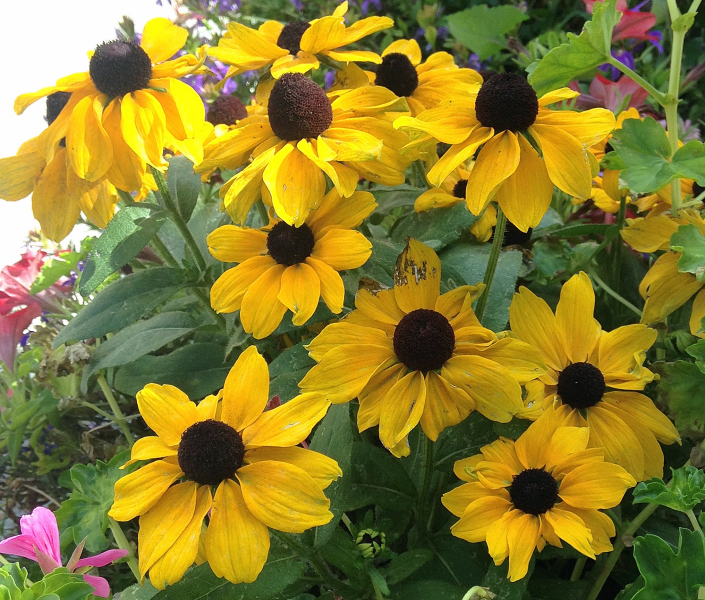| "Descrizione" by Handy23 (4286 pt) | 2024-Feb-22 17:28 |
Review Consensus: 8 Rating: 8 Number of users: 1
| Evaluation | N. Experts | Evaluation | N. Experts |
|---|---|---|---|
| 1 | 6 | ||
| 2 | 7 | ||
| 3 | 8 | ||
| 4 | 9 | ||
| 5 | 10 |
Echinacea purpurea è originaria del Nord America, diploide con 22 cromosomi nelle cellule somatiche, appartiene alla famiglia delle Asteraceae.
Vi sono diverse tipologie di Echinacea, leggermente differenti, ma con la caratteristica comune di somigliare ad una grande margherita.

Può raggiungere l'altezza di 150 cm e i 15 cm di larghezza.
L'echinacea contiene diversi composti bioattivi, tra cui polisaccaridi, flavonoidi, alchilamidi e oli essenziali. Questi composti conferiscono alla pianta proprietà immunomodulatorie, antiossidanti, antimicrobiche e anti-infiammatorie.
Attività biologiche
Gli estratti di Echinacea Purpurea hanno dimostrato di attivare macrofagi, cellule natural killer e leucociti polimorfonucleati. Anche se i cambiamenti nelle attività delle cellule T e B sono stati segnalati, i risultati sono meno certi.
Potenziale terapeutico
L'echinacea è tradizionalmente utilizzata per prevenire e trattare infezioni delle vie respiratorie superiori, come il raffreddore comune. Nonostante ci siano dati promettenti, l'efficacia nel trattamento delle malattie o nel migliorare la salute umana non è ancora stata dimostrata oltre ogni ragionevole dubbio.
Applicazioni industriali e farmaceutiche.
Gli estratti di echinacea sono utilizzati nella produzione di integratori alimentari e prodotti farmaceutici. Sono anche impiegati in cosmetica per le loro proprietà benefiche sulla pelle.
Studi
E' una pianta nota per le sue proprietà immuno-difensive (1) soprattutto contro il raffreddore, influenza, tosse e, in genere le malattie da raffreddamento (2) nonché proprietà antinfiammatorie.
I dubbi (3) sull'efficacia di questa ed altre pianticelle sono stati risolti positivamente con esperimenti di laboratorio.
Alcune tipologie :
Echinacea purpurea
Echinacea angustifolia
Echinacea pallida
Echinacea purpurea "Magnus"
Echinacea purpurea "Rubinstein"
Echinacea purpurea "White lustre"
Echinacea purpurea "White Swan"
Bibliografia_________________________________________________________________________
(1) Fonseca FN, Papanicolaou G, Lin H, Lau CB, Kennelly EJ, Cassileth BR, Cunningham-Rundles S. Echinacea purpurea (L.) Moench modulates human T-cell cytokine response. Int Immunopharmacol. 2014 Mar;19(1):94-102. doi: 10.1016/j.intimp.2013.12.019. Epub 2014 Jan 13.
PMID: 24434371
(2) Di Pierro F, Rapacioli G, Ferrara T, Togni S. Use of a standardized extract from Echinacea angustifolia (Polinacea) for the prevention of respiratory tract infections. Altern Med Rev. 2012 Mar;17(1):36-41.PMID: 22502621
Abstract. Echinacea preparations are extensively used for the prevention and the management of the common cold. Despite this popularity, the clinical studies on Echinacea have produced mixed results, possibly in part because of the poor characterization of the extracts investigated and the use of different species and/or plant parts for the preparations investigated in the various trials. To address this issue, Polinacea, a highly standardized extract from a well-defined botanical source (roots of Echinacea angustifolia) with a specific phytochemical profile (presence of the complex polysaccharide IDN5405, the phenylethanoid echinacoside, and substantial lack of alkamides) was developed. We have studied whether Polinacea could enhance the immune response subsequent to the influenza vaccination, and whether the use of this preparation could translate into a decreased morbidity from influenza. The preliminary results were encouraging, and suggest that Polinacea could be used for improving the immune response to influenza vaccine.
(3) Vetvicka V, Vetvickova J. Natural immunomodulators and their stimulation of immune reaction: true or false? Anticancer Res. 2014 May;34(5):2275-82. PMID: 24778031
Abstract. Natural immunomodulators are getting more and more popular. The popularity, however, often brings over-optimistic claims and mediocre effects. The purpose of the present study was to directly compare eleven most commonly used immunomodulators. Through testing both cellular and humoral branches of immune reactions, we found that most of the immunomodulators tested have limited, if any, effects, with glucan being consistently the most active molecule strongly stimulating every reaction evaluated. These data were also confirmed using a Lewis lung cancer model, where only glucan and resveratrol lowered the number of metastases.
| Evaluate |
